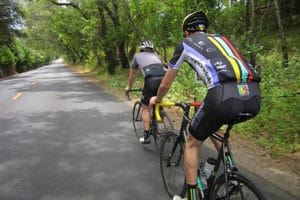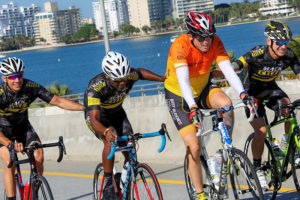The Benefits of Indoor Cycling:
Can Spinning Alone Prep You for a 100-mile Ride?
 Richard Fries is the Director of Cycling Experience for the Best Buddies Challenges. With more than 40 years experience, he has been a racer, commuter, tourist, promoter, advocate, journalist and commentator on the sport and lifestyle of cycling. Having raced at the professional level both in America and Europe, Fries is well known as a race announcer having called countless USA Cycling National Championships, World Cups, and UCI World Championships. But he is also a tireless advocate having recently served as the executive director of MassBike. You can follow him on Strava to learn more.
Richard Fries is the Director of Cycling Experience for the Best Buddies Challenges. With more than 40 years experience, he has been a racer, commuter, tourist, promoter, advocate, journalist and commentator on the sport and lifestyle of cycling. Having raced at the professional level both in America and Europe, Fries is well known as a race announcer having called countless USA Cycling National Championships, World Cups, and UCI World Championships. But he is also a tireless advocate having recently served as the executive director of MassBike. You can follow him on Strava to learn more.
The rising popularity of spinning, or indoor cycling, is profound. Whether at neon studios with instructors and pumping music or via in-home spin bikes with online services such as Peloton, Zwift or BKool legions of Americans are getting turned on to cycling.
One of my better friends, Tom Francis, is a regional champion and a legend amongst New England master racers (he also volunteers as a Best Buddies Challenge Domestique!). His regimen blends hours and hours of slow utility miles on the bike – commuting, shopping, running errands, socializing, etc. and a few sessions of intense indoor spin classes per week.
Experienced cyclists typically welcome anything that serves as a gateway to the amazing world of bicycles. Spinning provides a low-impact, high intensity session that can improve cardiovascular health. While spin classes may lack a sense of open road adventure, they offer a fun training regimen without the downsides of angry motorists, punctured tires, foul weather, darkness and mastering those pesky pedals and shoes at the stop light.
In a recent survey, Americans were asked how they reacted to the idea of bicycling for transportation. While 33 percent answered “no way, no how”, 1 percent checked off the “strong and fearless box,” and 7 percent described themselves as “enthused and confident.”
But, a whopping 60 percent described themselves as “interested but concerned.” That is a huge portion of the population that is being drawn towards bicycles through indoor riding.
So is indoor cycling good? Yes! However, people often ask if they could simply train indoors until the big day of the Best Buddies Challenge.
The answer is no. While it can be integrated into a comprehensive fitness regimen, spinning fails to develop three core elements required to complete a 100-mile ride in a large group.
- A rider needs develop critical cycling skills, outside of teaching folks how to use clipless pedals. Understanding shifting gears and braking is just the start. Cornering, climbing, descending, riding in a straight line, and managing assorted road surfaces are all crucial to keeping safe. Managing weather conditions, especially wind and rain, requires another repertoire of skills.
- A rider should have general competence in those departments before approaching the second of the core elements to master: riding in a large group of cyclists. Rolling off the line surrounded by hundreds of other cyclists all riding within inches of each other gives pause to the bravest of athletes. Group riding requires years to master. (See our blog on the the Tao of Riding 2×2).
- While spinning is great for developing cardiovascular fitness, it falls short in two key metrics: developing real endurance and burning fat. Data-crazed road cyclists focus on a key metric, the power-to-weight ratio. This is a rider’s “functional threshold power” measured in the watts they can produce for an hour divided by their weight measured in kilograms. Sounds kind of dense, huh?
To learn more on those metrics, read our recent blog on decoding bike data. Any rider that seeks to increase that watts per kilo number has to either increase their power output, decrease their weight, or – optimally – do both. And, while spinning is great, it falls short in both categories.
Let me break this into the two components, first is how cyclists increase their sustainable power. The standard method is long, slow distance rides of at least three hours in duration, preferably longer. Often referred to as base miles, these are long rides spent at a talking pace. Complete a five-hour ride and you’ll feel parts of your legs, your back, your core and your butt in all new ways. Your body’s response to that will build your endurance and raise your power output.
The second component to this debate is weight loss. In a strict clinical sense high intensity interval training (HIIT) does burn calories at a higher rate. But what’s burning? During high intensity effort the body burns mostly sugars. This is why I refer to those valuable one-hour gym workouts as “sugar pops.” They do a lot of good, but it’s not enough for an endurance cyclist seeking to do a 100-mile ride with any degree of proficiency.
During those long endurance rides the body will be forced to burn fats. Experienced riders will all describe the unique sensation around the third hour of a long ride when their body seems to switch on a new engine. Some refer to this as their diesel engines.
Dr. Allen Lim, who has worked with countless pro cyclists and Tour de France teams, uses the metaphor of a candle. With the wick representing sugars, or carbohydrates, and wax representing fats. We need both. But the trick for a long burning candle is to burn the wax, not the wick. And a long ride with rolling terrain or changing winds require the body of a road cyclist to dance between wax and wick.
There are a lot of other beneficial elements – some social, some psychological, and others chemical – to being outdoors and surrounded by nature that spin classes cannot replicate. We’ll save those for later blogs. But this article in The New York Times is a good overview.
Am I discouraging indoor cycling? No. The benefits of spinning are enormous, the classes are fun, and the training is a convenient solution to a time-crunched schedule, especially during the cold and dark months of winter. Indoor cycling can, and should be, interwoven into a year round training plan with a few sessions each week. But know that completing the Best Buddies Challenge ride requires real road work.



